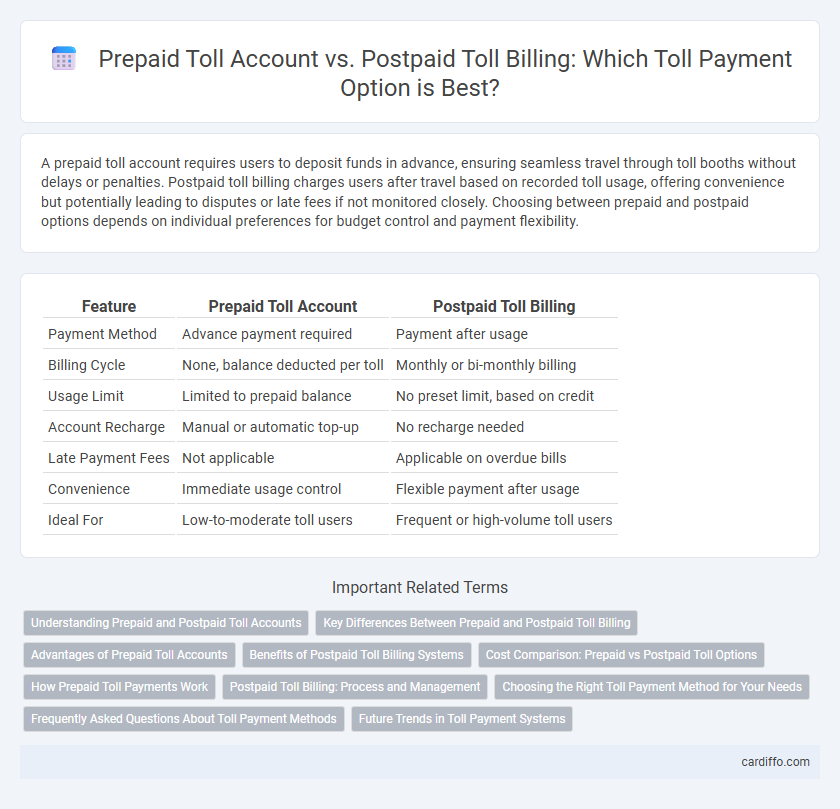A prepaid toll account requires users to deposit funds in advance, ensuring seamless travel through toll booths without delays or penalties. Postpaid toll billing charges users after travel based on recorded toll usage, offering convenience but potentially leading to disputes or late fees if not monitored closely. Choosing between prepaid and postpaid options depends on individual preferences for budget control and payment flexibility.
Table of Comparison
| Feature | Prepaid Toll Account | Postpaid Toll Billing |
|---|---|---|
| Payment Method | Advance payment required | Payment after usage |
| Billing Cycle | None, balance deducted per toll | Monthly or bi-monthly billing |
| Usage Limit | Limited to prepaid balance | No preset limit, based on credit |
| Account Recharge | Manual or automatic top-up | No recharge needed |
| Late Payment Fees | Not applicable | Applicable on overdue bills |
| Convenience | Immediate usage control | Flexible payment after usage |
| Ideal For | Low-to-moderate toll users | Frequent or high-volume toll users |
Understanding Prepaid and Postpaid Toll Accounts
Prepaid toll accounts require drivers to load funds onto their account before using toll roads, ensuring seamless payment without interruptions. Postpaid toll billing allows users to travel first and settle toll charges later through monthly invoices, offering convenience but requiring credit validation. Choosing between prepaid and postpaid toll options depends on individual budgeting preferences and payment flexibility.
Key Differences Between Prepaid and Postpaid Toll Billing
Prepaid toll accounts require users to deposit funds in advance, deducting charges automatically as tolls are incurred, ensuring no outstanding balances and immediate account control. Postpaid toll billing allows driving first and paying later, generating invoices based on accumulated toll usage, which can lead to delayed payments or penalties if bills are not settled on time. Key differences include payment timing, risk of overdue fees in postpaid systems, and convenience versus control, with prepaid accounts promoting budget management and postpaid focusing on usage flexibility.
Advantages of Prepaid Toll Accounts
Prepaid toll accounts offer greater cost control by allowing drivers to load funds in advance, preventing unexpected charges and ensuring seamless travel through toll plazas. They provide real-time account balance monitoring and automatic top-up options, reducing the risk of fines or penalties due to insufficient funds. Prepaid systems also facilitate faster processing at toll booths, minimizing delays and enhancing overall convenience for frequent commuters.
Benefits of Postpaid Toll Billing Systems
Postpaid toll billing systems offer enhanced convenience by allowing drivers to use toll roads without the need for upfront payment or account management. These systems provide accurate and consolidated billing, reducing administrative overhead and simplifying expense tracking for both individual users and fleet operators. Furthermore, postpaid options enable flexible payment methods and detailed usage reports, improving financial transparency and control.
Cost Comparison: Prepaid vs Postpaid Toll Options
Prepaid toll accounts offer fixed upfront costs that help control expenses and avoid unexpected charges, while postpaid toll billing provides convenience with monthly statements but may lead to higher fees and interest on delayed payments. Prepaid options typically include discounted toll rates and eliminate late payment penalties, making them cost-effective for frequent travelers. Postpaid billing may incur administrative fees, making prepaid toll accounts a preferred choice for budgeting and minimizing overall toll expenses.
How Prepaid Toll Payments Work
Prepaid toll payments require users to deposit funds into an account before using toll roads, ensuring seamless travel without stopping to pay at toll booths. Transactions automatically deduct the toll fee from the prepaid balance using electronic transponders or license plate recognition technology. This system enhances convenience, reduces traffic congestion, and allows users to monitor and recharge their accounts online or via mobile apps for continuous service.
Postpaid Toll Billing: Process and Management
Postpaid toll billing involves recording toll usage first and billing the vehicle owner afterwards, allowing for consolidated monthly statements instead of immediate payments. The process requires accurate vehicle identification through electronic toll collection systems, data validation, and secure invoice generation to ensure correctness and transparency. Effective management includes handling disputes, timely payment collections, and integration with financial systems for streamlined revenue processing.
Choosing the Right Toll Payment Method for Your Needs
Choosing between a prepaid toll account and postpaid toll billing depends on your travel frequency and payment preferences. Prepaid toll accounts offer control over expenses and prevent unexpected charges by requiring funds upfront, making them ideal for regular commuters. Postpaid toll billing allows for convenience without advance payment, suitable for occasional travelers who prefer monthly consolidated statements.
Frequently Asked Questions About Toll Payment Methods
Prepaid toll accounts require users to load funds in advance, enabling seamless toll payments without delays or penalties, while postpaid toll billing charges users after toll usage, often generating monthly invoices. Common questions address differences in payment flexibility, account management, and dispute resolution processes. Understanding these distinctions helps drivers choose the most convenient and cost-effective toll payment method for their travel habits.
Future Trends in Toll Payment Systems
Prepaid toll accounts enable drivers to load funds in advance, promoting seamless and quick transactions, while postpaid toll billing charges users after travel, offering greater flexibility. Emerging trends indicate a shift towards integrated, AI-driven toll payment systems utilizing real-time data analytics for personalized billing and enhanced traffic management. Future toll systems are also expected to incorporate blockchain technology to ensure transparent and secure transactions across multiple jurisdictions.
Prepaid toll account vs Postpaid toll billing Infographic

 cardiffo.com
cardiffo.com